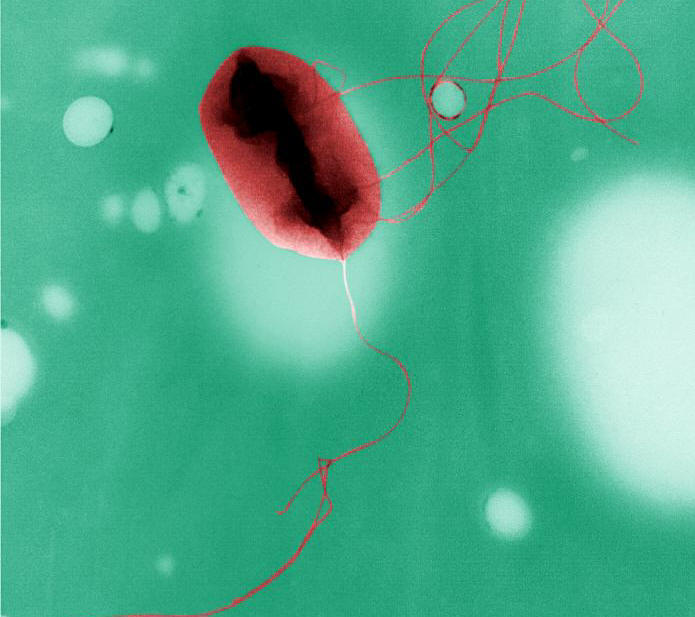Enterohemorrhagic Escherichia coliOverview: Enterohemorrhagic Escherichia coli (O157:H7) (EHEC) is a Gram-negative, rod-shaped bacterium that causes food-borne illnesses (Figure 1). Normally, E. coli serves a useful function in the body by suppressing the growth of harmful bacterial species, and by synthesizing appreciable amounts of vitamins. However, this particular serotype of E. coli is a rare variety that produces large quantities of one or more related potent toxins that cause severe damage to the lining of the intestine. These toxins (verotoxin, shiga-like toxin) are closely related, or identical to the toxin produced by Shigella dysenteriae. Infection often leads to hemorrhagic diarrhea (inflammation of the bowel), especially in young children and elderly. If not treated, these symptoms can lead to haemolytic uremic syndrome, a condition that results in the destruction of clotting cells (thrombocytopenia) and red blood cells (hemolytic anemia), subsequently leading to kidney failure. Most illnesses have been associated with eating undercooked, contaminated groundbeef, drinking unpasteurized milk, swimming in or drinking contaminated water, and eating contaminated vegetables.
Figure 1. This is a colorized transmission electron micrograph of Escherichia coli O157:H7 showing its flagella. Identification: There are a number of characteristics microbiologists can use to identify EHEC. In particular, this pathogen is sorbitol-negative and lacks the ability to hydrolyze 4-methylumbelliferyl-β-D-glucuronide, a substrate used for detecting glucuronidase enzyme activity. On cefeximine potassium tellurite sorbitol-MacConkey agar, O157:H7 colonies appear clear due to their inability (unlike other E. coli serotypes) to ferment sorbitol. Non-sorbitol fermenting colonies are tested for the somatic O157:H7 antigen before being confirmed as EHEC. In addition, this bacteria is anaerobic and cannot grow in the presence of bile salts; because of the latter characteristic, this serotype cannot be isolated by using standard fecal coliform methods. Immune Evasion and Infection: In order to cause damage to its host, this pathogen has been characterized to produce virulence factors like periplasmic catalase and shiga-like toxins. The periplasmic catalase is encoded on the pO157 plasmid and provides oxidative protection during infection (Kaistha & Sinha, 2009). Recall that oxidative burst is a central component of the macrophage's arsenal against bacteria and parasites. If oxidative burst is rendered ineffective, the host must find an alternate route to kill the pathogen. Moreover, the shiga-like toxin acts on the lining of the blood vessels, the vascular endothelium. It is made-up of an A-subunit which is toxic, and a B-subunit of the toxin that binds to a component of the cell membrane known as Gb3, and subsequently allows enters into the cell. When the protein is inside the cell, the A-subunit interacts with the ribosomes by catalytically inactivating the 60S ribosomal subunit of the eukaryotic protein translation machinery, which brings a halt to protein synthesis leading to the death of the cell. The vascular endothelium has to continually renew itself, so this killing of cells leads to a breakdown of the lining and to hemorrhage. The first response is commonly a bloody diarrhea. This is because Shiga toxin is usually taken in with contaminated food or water. Treatment: Most people recover from EHEC infection without antibiotics or other specific treatment within five to ten days. There is no evidence that antibiotics improve the course of disease, and it is thought that treatment with some antibiotics may precipitate kidney complications. Antidiarrheal agents, such as loperamide (imodium), should also be avoided. Haemolytic uremic syndrome is a life-threatening condition usually treated in an intensive care unit. Blood transfusions and kidney dialysis are often required. With intensive care, the death rate for hemolytic uremic syndrome is 3 to 5%. Prevention: Cooking all ground beef and hamburgers thoroughly, and checking the temperature using an instant-read meat thermometer, will eliminate the organism. Ground beef should be cooked until a thermometer inserted into several parts of the patty, including the thickest part, reads at least 72°C (162 °F). Do not eat your steaks rare or medium rare; instead, have it cooked well-done or even overcooked. When preparing meat, it should be kept separate from other food items and all surfaces, and utensils which come into contact with raw meat should be washed thoroughly before being used again. Hand washing is also important. Placing cooked hamburgers or ground beef on an unwashed plate that held raw patties can transmit infection. Unpasteurized milk, juice, and cider are potential sources of E. coli. Commercial juice is almost always pasteurized, and juice concentrates are also heated sufficiently to kill pathogens. In addition, fruits and vegetables should be washed thoroughly, especially those that will not be cooked. Contaminated water should be boiled at a rolling boil for at least one minute (longer at higher altitudes) before consumption. Care while swimming to avoid ingestion of potentially contaminated water can reduce the chances of infection. Proper hand washing after using the lavatory or changing a diaper, especially among children or those with diarrhea, reduces the risk of transmission. Anyone with a diarrheal illness should avoid swimming in public pools or lakes, sharing baths with others, and preparing food for others. References: Kaistha, S.D., & Sinha, R. (2009).Homology modeling of phosphoryl thymidine kinase of enterohemorrhagic Escherichia coli OH: 157, 3(6): 240–243. |

